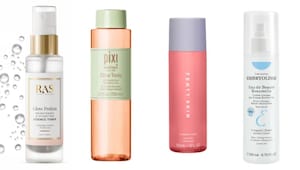Dissolving fillers is so in!
Everyone’s going (almost) au naturale...

The days of the ‘Instagram face’ characterised by pouty lips, excessively high cheekbones, and protruding chins, seem to be nearing an end. Even Kylie Jenner decided to say goodbye to some of her lip fillers—the very thing that catapulted her to fame and the lip kits that followed. Now, social media has turned against dermal fillers, scrutinising their impact on celebrity faces and citing multiple complications such as filler migration. Though injectables are considered largely non-invasive, people's dissatisfaction with results prompted the trend of filler removal and dissolving. And if you're considering the same, here’s a breakdown of questions and concerns you may have.
How does one dissolve a filler?
A dermal filler can be dissolved quite easily when it is made of hyaluronic acid, it is dissolved by an enzyme called hyaluronidase. “The hyaluronidase is injected in the filler area to be dissolved and it breaks down the hyaluronic acid molecule,” says Dr Madhuri Agarwal, founder of Yavana Aesthetics Clinic. She stresses the importance of having an experienced certified dermatologist to dissolve the fillers in order to mitigate risks. Though most fillers may dissolve within 24 hours, it’s best to wait for a week for the complete result. However, you must know that in some cases, fillers are made up of other ingredients that may not be so easy to get rid of, for example, calcium hydroxyapatite, polylactic acid, or polymethyl methacrylate, which are non-dissolvable. For non-dissolvable fillers, Dr Agarwal recommends a surgical procedure with an experienced plastic surgeon to extract the filler.
The rise of filler dissolving
Board-certified dermatologist, Dr Jaishree Sharad attributes the rise of filler dissolving to an unnecessary rise in filler injections. “People have been going overboard and injecting fillers as frequently as 4-6 months and sometimes that leads to accumulation of a lot of product leading to puffiness and swelling”, she adds. A lot of actors and influencers from the West started to develop an over-accumulation of hyaluronic acid and needed to get it dissolved, the likes of Kylie Jenner, Ariana Grande, and even Iggy Azalea fall into this category. Duck lips and swollen under eyes are an undesirable look, so it’s no surprise that many might be opting to dissolve their injectables. Dr Madhuri Agarwal ADDS, “The awareness surrounding filler dissolving has gone up and people are more pliable to dissolving their fillers when they look unnatural or overfilled.”
Risks and side-effects
Common side effects include temporary discomfort at the injection site, redness, swelling, bruising, and, very rarely, an allergic reaction. Some temporary bruising and swelling can occur but typically resolve quickly. It’s also possible to experience sudden hollowing or depression due to the filler’s disappearance. Above all, it’s crucial to consult an experienced dermatologist to avoid issues such as migrated fillers, lumps, or allergic reactions. If an allergic reaction occurs, Dr Sharad recommends using antihistamines to alleviate swelling and itching.
How long does it take?
The time it takes to dissolve fillers depends on several factors, including the type and amount of filler injected and the dosage of hyaluronidase used. "When hyaluronidase is injected, the dissolving of fillers begins immediately, with the most significant response occurring within the first 48 hours. Sometimes, the dissolution may require a few sessions to achieve more precise results," explains Dr Agarwal. Hyaluronic acid fillers often dissolve naturally over time. A light filler can dissolve in as little as 6 months, while deeper fillers, such as those used in the nose, jawline, or chin, may last two or three years before naturally breaking down.
Can we let the fillers dissolve naturally?
The natural dissolving of fillers can vary depending on the injected area; for example, fillers in areas with more movement, such as the lips, tend to disappear faster than those in less dynamic areas like the undereye. Additionally, the quantity of filler used, the individual's metabolism (people with faster metabolisms may break down fillers more quickly), and their lifestyle habits can also affect how quickly the filler dissolves.
What are the chances of filler migration?
The chances of migration of filler are rare when done by an experienced dermatologist. A filler is less likely to migrate when the quality of the filler is superior and requisite checks and approvals are there. The care taken by patients after filler injection is crucial as frequent manipulation or massage of the filler area immediately after treatment increases the risk of migration. According to Dr Sharad, “Filler migration can happen if you overfill. It can also occur if the fillers are injected in the wrong place or done superficially.”
The aftercare
It is recommended to avoid alcohol, exercise, and strenuous activity for the first 24 hours post-procedure. Also, it is best to avoid extreme heat as well as cold, and not apply pressure to the affected area.
Hyaluronic acid fillers are easily reversible, and depending on how you see it, that can be a boon or a curse. Dissolving is on-trend right now as we embrace our natural features (and flee from botched jobs). And well, there’s always overlining, contouring, and face sculpting for the days you feel like accentuating your features!
Feature image: Pexels
Also read: Viral beauty products that are worth every penny
Also read: These water-based sunscreens are your answer to the humid weather
more from Beauty

The best makeup tonics to upgrade your skincare and makeup routine

Why blush balms are the low-effort glow stick for fuss-free radiance

Scents that make staying in feel like a winter wonderland

'Bridgerton' season 4 trailer: Benedict and Sophie are ready to serve a Cinderella-esque romance

Taylor Swift's exact workout that kept her stage ready for the Eras Tour

“Pebbling” is the non-toxic, genuinely adorable dating trend we all needed

Is 'future faking' the new gaslighting? Decoding this new dating trend

Bad at gifting? Check out these stocking stuffer ideas based on each zodiac sign

15 new Christmas movies you might want to add to your 2025 holiday watch list

Why glycolic acid is your skin's best friend for the winter season
